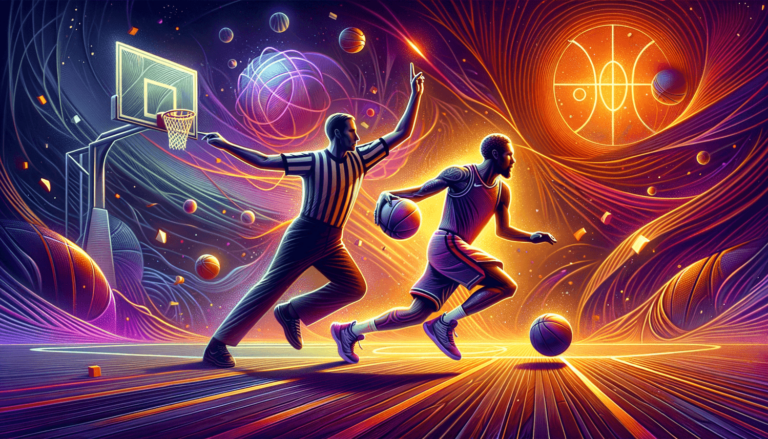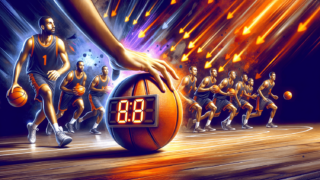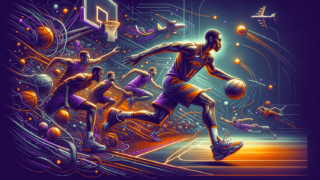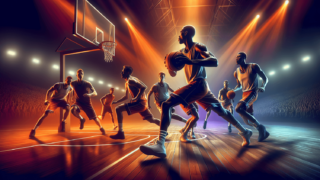
If you’ve ever watched a thrilling basketball game and found yourself puzzled by the term ‘double dribble,’ then you’ve come to the right place! In this blog post, we’ll dive deep into the heart of this critical rule that every basketball enthusiast should know. The fast-paced, high-flying world of basketball is filled with impressive on-court skills, but more importantly, it’s governed by precise rules that keep the game fair and entertaining. So, buckle up as we take you on a fun and professional journey into the realm of double dribbles, leaving no stone unturned as we explore this essential aspect of the beloved sport.
What Is a Double Dribble in Basketball?
A double dribble is a violation in basketball that occurs when a player illegally dribbles the ball twice, touches the ball with both hands simultaneously during a dribble, or starts a new dribble after coming to a stop. This rule maintains the flow of the game and prevents players from gaining an unfair advantage. When a double dribble is called, the offending team loses possession and the opposing team is awarded the ball.
Understanding the Basic Elements of a Double Dribble
Basketball is an intricate game with rules that govern every aspect of its play. Among these rules is the double dribble, a fundamental yet sometimes misunderstood basketball term. Before we dive into the nitty-gritty, let’s explore the foundational elements of dribbling and the basics of a double dribble.
Dribbling 101
In basketball, dribbling is a fundamental skill that involves bouncing the ball on the court with one hand while the player moves around. Dribbling allows a player to advance the ball up and down the court, pass to teammates, and create scoring opportunities. There is a technique to effective dribbling, as it involves control, good posture, and using the fingertips to bounce the ball rather than slapping it with the palm.
Key Components of a Double Dribble
Now that we have a basic understanding of dribbling, let’s dissect the double dribble. As previously mentioned, a double dribble can occur in three scenarios:
- A player dribbles the ball with both hands simultaneously.
- A player dribbles, holds the ball, and then starts dribbling again.
- A player dribbles, comes to a complete stop, and then starts dribbling again.
Let’s look at each of these scenarios in more detail.
The Two-Handed Dribble: A Forbidden Technique
While dribbling, a player must always use only one hand to bounce the ball. In essence, two hands touching the ball at the same time is a double dribble. Basketball is designed to be fast-paced, and as such, using two hands to dribble would give a player an unfair advantage in maintaining control of the ball. This rule ensures that the game remains balanced and challenging for all players involved.
How to Spot a Two-Handed Dribble
Identifying a two-handed dribble is relatively straightforward, as the player’s hands will be in direct contact with the ball. Referees and other players are generally vigilant when it comes to this type of double dribble, as it’s easy to spot in the heat of the game. To improve your skills and avoid this violation, practice dribbling with alternate hands at varying speeds and using only one hand at a time.
Restarting a Dribble: A Common Mistake
Another form of double dribble occurs when a player stops dribbling, holds the ball, and then proceeds to dribble again. Once a player stops their dribble, they must either pass or shoot the ball; they cannot reinitiate a new dribble. Doing so would provide an unfair advantage and disrupt the flow of the game.
Identifying a Restarted Dribble
Determining whether a player has restarted a dribble can sometimes be subjective, depending on the specific circumstances in play. However, generally speaking, if a player maintains clear control of the ball and stops their dribble before beginning a new one, it is considered a double dribble. By understanding this aspect of the rule, you can better develop your dribbling skills and decision-making abilities to avoid committing this violation on the court.
Stopping and Starting: Another Form of Double Dribble
Lastly, a player cannot stop dribbling, completely halt their movement, and then resume dribbling. Doing so is considered a double dribble and will result in a violation. Once a player’s dribble comes to a complete stop, they must either pass or shoot the ball without restarting their dribble.
The Subtleties of a Stopped Dribble
Identifying a stopped dribble can be complicated, as some situations might be open to interpretation. For example, a player could slow their dribble to a crawl, giving the appearance of a stop, but still maintain a legal dribble. It’s essential as a player and spectator to recognize the intricacies of this rule and how close calls can impact the game.
Why Double Dribble Matters: The Impact on the Game
At first glance, the double dribble rule may not seem as crucial as other rules in basketball. However, preventing double dribbles ensures the game remains fair, balanced, and competitive. Here’s why double dribbles are crucial to basketball:
Maintaining the Game’s Integrity
Basketball rules are in place to create an equal playing field for all participants. By restricting specific dribbling techniques, such as double dribbles, the game retains its integrity and demands players develop proper dribbling techniques to succeed.
Encouraging Teamwork and Strategy
By prohibiting double dribbles, players are required to think critically about their next move once their dribble stops. This emphasizes the importance of teamwork and strategic decision-making, as players must assess whether to shoot or pass the ball in any given situation.
Preventing Stalling Tactics
Without the double dribble rule, teams with a lead could unfairly stall the game by continuously dribbling and reinitiating their dribble without making any progress down the court. This would make for a slow and less engaging basketball experience.
How to Avoid a Double Dribble: Tips for Success on the Court
As you strive to improve your basketball skills and knowledge, avoiding double dribble violations should be a top priority. Here are some tips to help you stay within the rules and maintain control on the court:
Practice Proper Techniques
Consistently work on your dribbling skills, focusing on using one hand at a time, switching hands smoothly, and maintaining control of the ball. The more comfortable you are with dribbling, the less likely you are to commit a double dribble.
Improve Decision-Making
Understanding when to pass or shoot and assessing situations on the court will help you avoid double dribble scenarios. By being aware of your options and anticipating possible outcomes, you will minimize the likelihood of committing a double dribble violation.
Speed and Agility Drills
Improving your overall speed and agility on the court will allow you to be more effective in dribbling and avoiding double dribbles. Incorporate speed and agility drills into your training routine to maximize your movement and maintain control.
Double Dribble: Elevated Gameplay Through Rules
Although it may seem like a small detail in the vast landscape of the sport, the double dribble rule plays a significant role in maintaining the integrity and competitiveness of basketball. By understanding the ins and outs of double dribbles, you’ll not only become a more informed player or spectator but also enjoy the excitement and fulfillment that the game offers. Remember, the key is in the details – so don’t dribble away your chances for success on the basketball court!
Spotting and Preventing Double Dribble: Tips for Coaches and Referees
Ensuring players follow the double dribble rule is crucial to maintaining the flow and competitive balance of a basketball game. As a coach or referee, it’s essential to have a deep understanding of the double dribble rule and be able to identify situations where it may occur. Here are some tips for coaches and referees to effectively manage double dribble scenarios on the court:
Clear Communication of the Rule
As a coach, it’s essential to emphasize the double dribble rule and other important aspects of the game during practice and pre-game discussions. Ensure your players understand the different scenarios in which a double dribble occurs, and make certain they are aware of the consequences of committing such a violation. As a referee, clear communication with the players and coaching staff regarding the rules helps ensure smooth gameplay.
Watch for Telltale Signs
Referees need to keep an eye out for common signs of a double dribble, such as a player touching the ball with both hands simultaneously or stopping their dribble and restarting. Understanding the nuances of the double dribble rule and being vigilant during games will help referees make accurate calls.
Teach Effective Techniques
Coach your players in refining their dribbling skills by incorporating drills and exercises that challenge their ability to maintain control and adapt to various game situations. Instill in them the importance of the fundamental skills needed to avoid double dribble violations at all levels of play.
Use Video Analysis
By analyzing past games and practice footage, coaches and players can identify instances where double dribble violations occurred, understand what led to those violations, and implement strategies to avoid them in future games. Video analysis is a powerful tool that can offer valuable insights and reinforce the importance of adhering to the rules.
Remedying a Double Dribble: What Happens Next?
When a double dribble violation occurs, it’s essential to understand the consequences and the best way to proceed during gameplay. Here’s what you need to know about addressing a double dribble:
Consequence of a Double Dribble
Upon the occurrence of a double dribble, the referee will stop the game and penalize the offending team by awarding possession to the opposing team. The opposing team will then inbound the ball from the sideline or baseline, depending on the location of the infraction.
Quick Recovery
As a player, swiftly correcting after a double dribble violation helps maintain game momentum and prevent further issues. Face the consequences and refocus your energy on proper form, technique, and decision-making. Use the violation as an opportunity to learn and improve your gameplay.
Encourage Proper Techniques
Coaches can use double dribble scenarios as teaching moments for their team. Encourage players to avoid double dribble violations by emphasizing the importance of proper technique, quick decision-making, and strategies that heighten their understanding of the game.
Demystifying Double Dribble: A Key Component of Winning Strategy
Double dribble may seem difficult to grasp fully, but understanding its role in basketball and how to prevent violations is integral to improving overall gameplay. By knowing the ins and outs of the double dribble rule and the best ways to avoid committing it, players, coaches, referees, and fans alike can contribute to a more enriched experience of the game. Keep refining your dribbling skills, heighten your situational awareness, and stay committed to the rules – that’s the winning formula for success on the basketball court.
Frequently Asked Questions about Double Dribble in Basketball
While we have covered much about double dribble in basketball, you may still have some questions. In this FAQ section, we’ve compiled a list of common questions and provided short yet informative answers to clear up any lingering uncertainty about this crucial rule.
1. Why can’t a player dribble the ball with both hands?
Dribbling with both hands simultaneously, known as a double dribble, is illegal in basketball because it gives a player an unfair advantage in maintaining control of the ball. The rule ensures balance, competition, and encourages the development of proper dribbling skills.
2. Is there a penalty for double dribble?
Yes, when a double dribble is called, the offending team loses possession, and the opposing team is awarded the ball for an inbound play from the sideline or baseline, depending on the location of the infraction.
3. How can I improve my dribbling skills to avoid double dribbles?
Practice dribbling techniques using one hand, alternating between hands, and maintaining control of the ball at varying speeds. You can also work on speed and agility drills and improve your situational awareness and decision-making on when to pass or shoot.
4. Can a player restart dribbling after catching their own airball or blocked shot?
Yes, as long as the player’s shot or layup attempt touched the rim or backboard before they regained possession, they can be allowed to resume dribbling without incurring a double dribble violation.
5. Is it ever legal to use two hands while dribbling?
No, using two hands simultaneously while dribbling is considered a double dribble and is illegal. Players must always use only one hand while dribbling.
6. What is the difference between a double dribble and a traveling violation?
A double dribble occurs when a player violates dribbling rules, such as dribbling with both hands or restarting a dribble after stopping. Traveling, on the other hand, occurs when a player moves without properly dribbling the ball, taking more than two steps without dribbling, or moving their pivot foot once they’ve established it.
7. How can I improve my decision-making on the court to avoid double dribbles?
Understand your options in various game situations and anticipate possible outcomes. Work on your ability to read defenses, know your teammates’ positions, and practice decision-making scenarios during training to minimize the likelihood of committing a double dribble violation.
8. Can a player dribble again after they lose control of the ball?
Yes, if a player unintentionally loses possession and control of the ball while dribbling, they may regain control and continue to dribble without it being considered a double dribble.
9. Is a double dribble the same in all levels of basketball?
Yes, the double dribble rule is consistent across all levels of basketball, including youth, high school, college, and professional leagues. The rule helps maintain the integrity, balance, and competitiveness of the game.
10. What’s the difference between a double dribble and a carry or palming?
A double dribble involves illegal restarting of a dribble or using both hands, while a carry or palming occurs when a player places their hand under the ball and lifts it while dribbling. Both violations result in a turnover and a change of possession.
11. Can a player momentarily touch the ball with both hands, as long as they don’t dribble?
Yes, a player can touch the ball with both hands as long as they don’t attempt to dribble. However, they must be cautious not to unintentionally commit a double dribble, carry, or traveling violation during the process.
12. Are there any other dribble-related violations in basketball?
Yes, besides double dribble, other dribble-related violations include carrying, traveling, over-and-back (crossing the midcourt line twice without the ball touching the frontcourt), and violations that result when dribbling out of bounds.
13. How can a coach teach players to avoid double dribble violations?
Coaches can educate players on the double dribble rule, provide examples of each scenario, and teach proper dribbling techniques. Incorporating dribbling drills, video analysis, and enhancing situational awareness during practice can also help reduce double dribble occurrences.
Featured Posts
- No pillar pages found.





